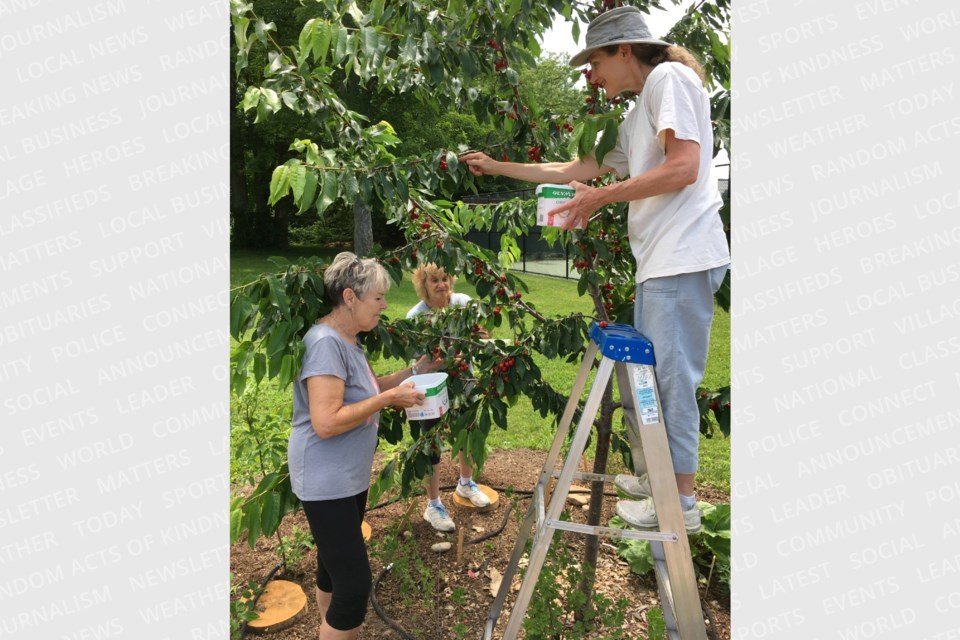What started from a tiny seed of an idea is now blossoming into an accessible and sustainable food forest in Fergus.
Located near the community garden at the Centre Wellington Community Sportsplex, members from Food Forest Centre Wellington recently harvested its first crop, producing almost 20 lbs of cherries.
The produce will go toward feeding families in need at the CW Mobile Market, a food rescue organization dedicated to helping reduce food insecurity in Centre Wellington.
“The cherries ripened so quickly. So, we thought that we should get in there right away and get them harvested,” said Food Forest Centre Wellington member Carole Pines.
“To see these little plants, to see how quickly they mature and start producing into something edible, it really is wonderful.”
A food forest is an alternative way of gardening and producing food, modelled on the natural structure of a forest. This can include food-producing trees, shrubs, vegetation, root vegetables and vines.
“It is a different approach compared to having just rows of crops. It’s a forest garden modelled on how a forest grows naturally,” Pines said.
“What we are doing here is emphasizing native plants and plants that produce food. So, rather than planting an elm tree, we have cherry and apple trees.”
Fellow member Kate Anderson has been gardening for many years and says the food forest includes many different plants that work together, each one having a role to create a sustainable ecosystem.
The goals for the alternative sustainable garden are to provide food for the community, while benefiting the environment by increasing native plant diversity, and creating a beautiful space for people to gather and volunteer.
“What excites me about this, is that it’s gardening with a purpose,” Anderson said. “For so many years, gardening has been focused on what looks nice, and on what’s attractive. But with our environment and climate today, along with the drastic decline in pollinators, we really need to look at new ways of utilizing the land. What I love about this model, is everything about it is organic and natural.”
Anderson hopes that township will see how successful the food forest is and that it will draw more people in.
“I would like to see more food forests spring up,” she said. “Rather than the township mowing big swathes of grass, they could be planting things that are beneficial to nature and to people. And there’s very little maintenance involved. To me, it’s just a no-brainer.”
Anderson says the food forest can act as a model for what people can do in their own yards.
“Even if it is on a small plot of land, this can also open up many educational opportunities, especially when it comes to nutrition,” she said.
“There is such a wide variety of things growing in the food forest. It’s about getting food from the land rather than processed food,” Anderson said.
Food Forest Centre Wellington came to be in February 2022.
“A community member was very interested in starting this project. Then six of us responded. We just showed up with a shovel, and asked her to tell us what to do,” Anderson said. “And now it’s turned out to be something much bigger than we first anticipated.”
Along with cherry trees, Food Forest Centre Wellington has an apple tree, as well as a variety of other fruits, herbs and vegetables.
“We have onions, mint, basil, oregano, thyme, chives, parsley, a bit of cilantro and wild ginger and sorrel,” Pines said.
“We will be getting some raspberries and blackberries and currant bushes. And we have squash, beans and peas. So, it will be one thing after another as the summer goes on.”
Pines says the food forest continues to be a learning experience for volunteers.
“We held a planting day and had a really good turnout. At least 15-20 people joined us. There’s a lot of interest from people who want to help and volunteer," she said.
Anderson says the general philosophy is to grow a largely perennial self-sustaining food forest.
“We decided that in the first two to three years, before the shrubs and the trees really begin to grow, we wanted to make good use of the soil. So, that is why we included some annuals too, like eggplant and tomatoes,” Anderson said.
“We don’t anticipate planting much in the way of annual vegetables, but right now, we have the space and we have the sun, so we are going for it this year.”
Pines says the food forest will help not only help feed humans, but also other small creatures in the area, to help keep the food chain going.
“It’s really great to be involved in a project that is community based. Having people come together with these common goals for something that will benefit the community and benefit the environment, it’s so rewarding,” Pines said.
“We are already looking at ways of seeing how we can expand and at how can we encourage others to do it too. Every little bit can help make a big change.”
Pines says the group will continue to post throughout the summer on the Food Forest Centre Wellington Facebook page, so community members can see what’s available.



.png;w=120;h=80;mode=crop)